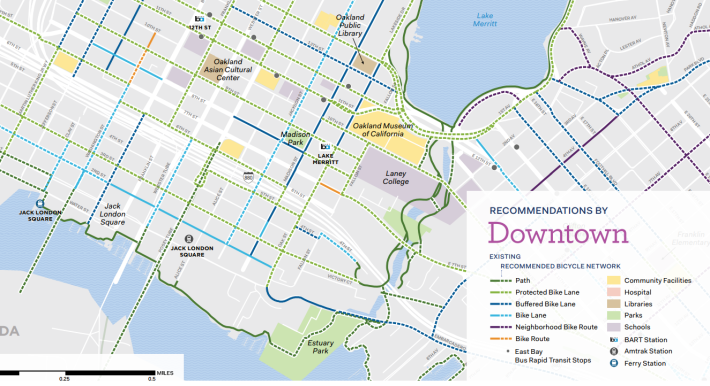"Move the bicycle route from MLK and 2nd Street to MLK and 4th Street," said Aaron Wright of the International Longshore and Warehouse Union, addressing Oakland's City Council on Tuesday, July 16, before a vote on a bike plan for downtown Oakland. "We're talking about a couple of blocks."
Wright was one of a handful of Port officials and representatives who spoke to the council and who continue to try to get the city to remove segments of long-planned protected bike lanes from Oakland's "Downtown Specific Plan."

Fortunately, safety advocates from Oakland were there to push back. "We have a traffic safety crisis on our hands in Oakland, and we need to take all available actions to prevent further deaths and injuries, especially for pedestrians and others outside of cars," said George Spies with Traffic Violence Rapid Response, in his address to the Oakland City Council. "West Oaklanders and folks across Oakland should be able to access the Jack London Square area, and Jack London residents to access West Oakland, Downtown and East Oakland. If trucking is to be kept on any routes which intersect or overlay adopted bike and pedestrian plans, the solution is separated lanes and proper sidewalks, as is best practice in the traffic management profession."
"Years of community engagement established the Oakland Bike Plan with a protected bike network on Market Street, MLK Jr. Way, and 3rd Street to keep us safe from car and truck traffic," said advocate Bryan Culbertson at the same meeting. "These plans were established prior to the ballpark, and with the ballpark no longer happening, it is the city's responsibility to revert to the existing and adopted bike plan to support the existing community."
As Streetsblog reported previously, Oakland's Maritime, Access, Sustainability, and Trade group (O-MAST), an amalgamation of port industry interests in Oakland, has for some time been lobbying Oakland's planning commission to water down the city's bike safety plans in and around the port.
9am this morning at MLK/3rd St in Oakland’s Jack London Square, where last week port interests claimed that semi traffic required 4 lanes & a raised protected cycletrack was infeasible. Thank you to city council for not buying it, & allowing the bikeway to proceed. pic.twitter.com/NkdA68R9B7
— Robert Prinz (@prinzrob) July 24, 2024
Trying to crop the MLK protected bike lane so it won't connect with the planned protected lane on 3rd was just the latest of those efforts. Nevertheless, in the end the original plan passed unanimously with only some minor alterations.
"The Downtown Specific Plan passed only with [District 1 Councilmember Dan] Kalb’s expected amendments. So that’s good," wrote Spies in an email to Streetsblog,
That means the Port still got some of what it wanted, notably the removal of the words “connectivity improvement” on Embarcadero West between Clay Street and Martin Luther King Jr. Way from the plan. Spies explained to Streetsblog that advocates weren't terribly concerned about this section of Embarcadero West, since it dead-ends at an industrial facility. Importantly, advocates blocked the port from rolling back the lane on MLK, which would have left cyclists exposed and unprotected when trying to connect with the planned 3rd Street protected bike lane.

"Regardless of what happens with the Downtown Specific Plan language, the bike plan still includes recommendations for protected facilities on Market, MLK, and 3rd Street," wrote Bike East Bay's Robert Prinz in an email to Streetsblog.

During the proceedings, District 5 Councilmember Noel Gallo remarked that the port employs Oaklanders and therefore it's important to look out for port interests. In Streetsblog's view, while that's true, it indicates a false dichotomy. Every street can be safe and still accommodate port operations, as indeed they do overseas. It just takes the right concrete infrastructure, not moving bike lanes to other streets and creating gaps in the planned protected bike network. It's bad enough that the port succeeded in rolling back a direct connection between MLK and Embarcadero West, which actually could be useful to cyclists trying to get to and from Oakland's ferry terminal.
That said, advocates warn that port officials are continuing to try to quash elements of the Oakland bike plan behind the scenes. "The O-MAST people were more than willing to make unfounded claims to advance their agenda of displacing active transportation to allow for unrestrained truck access," said Spies. "So advocates have a job ahead."





